Comprehensive Review of Clinical Management for Cervical Spondylosis
VerifiedAdded on 2023/06/18
|5
|810
|436
Report
AI Summary
This report reviews the clinical management of cervical spondylosis, a condition characterized by age-related wear and tear in the cervical spine. It discusses differential diagnoses, including nonspecific neck pain and mechanical lesions, and outlines common symptoms such as tingling, numbness, and loss of coordination. Diagnostic methods like X-rays, CT scans, and MRIs are explored, along with various management approaches ranging from manual therapy and exercise to drugs, injections, and surgical interventions. The review concludes that manual therapy exercise is the most effective initial treatment, with injections and drugs considered for persistent pain, and surgery reserved for severe cases with potential for serious damage. The document is available on Desklib, a platform offering past papers and solved assignments for students.
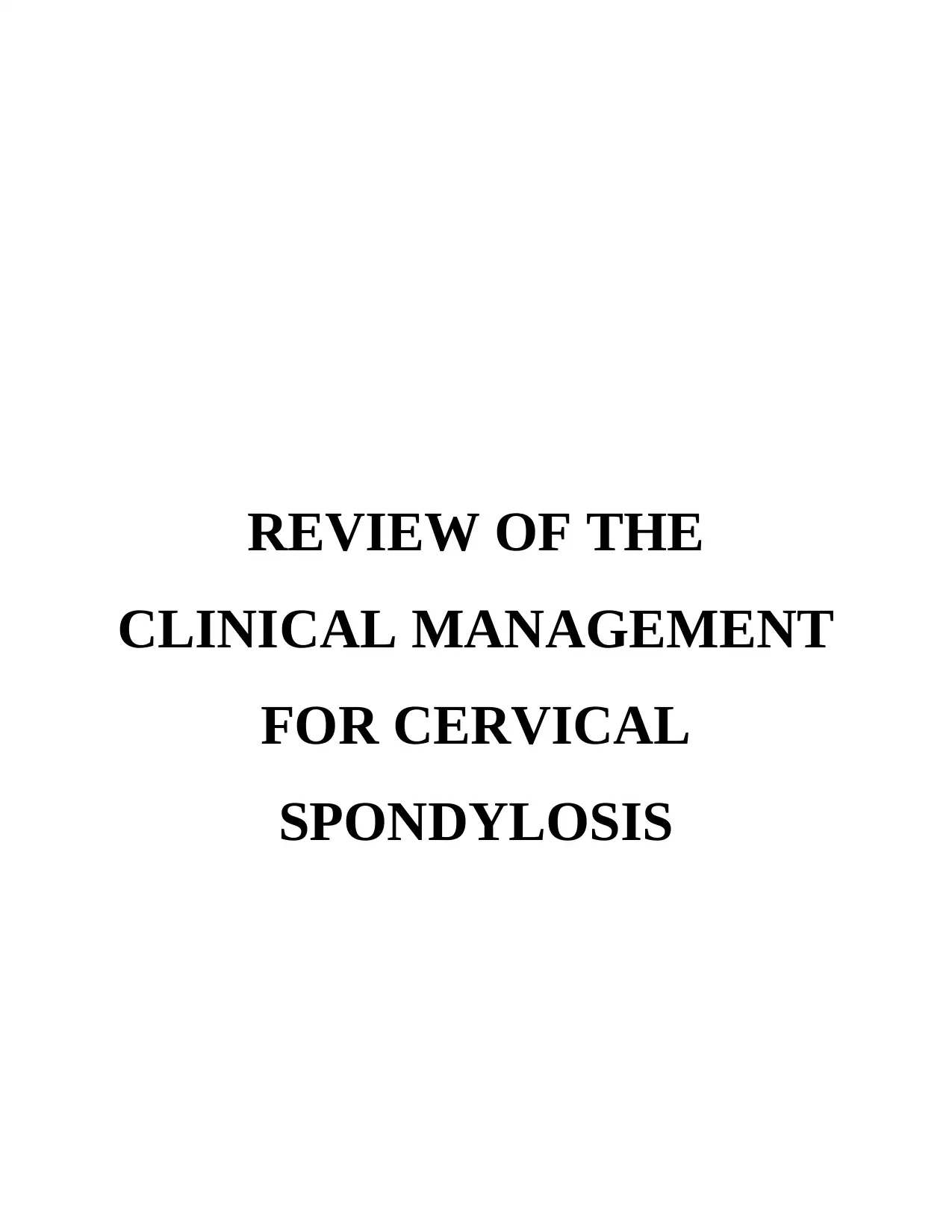
REVIEW OF THE
CLINICAL MANAGEMENT
FOR CERVICAL
SPONDYLOSIS
CLINICAL MANAGEMENT
FOR CERVICAL
SPONDYLOSIS
Paraphrase This Document
Need a fresh take? Get an instant paraphrase of this document with our AI Paraphraser
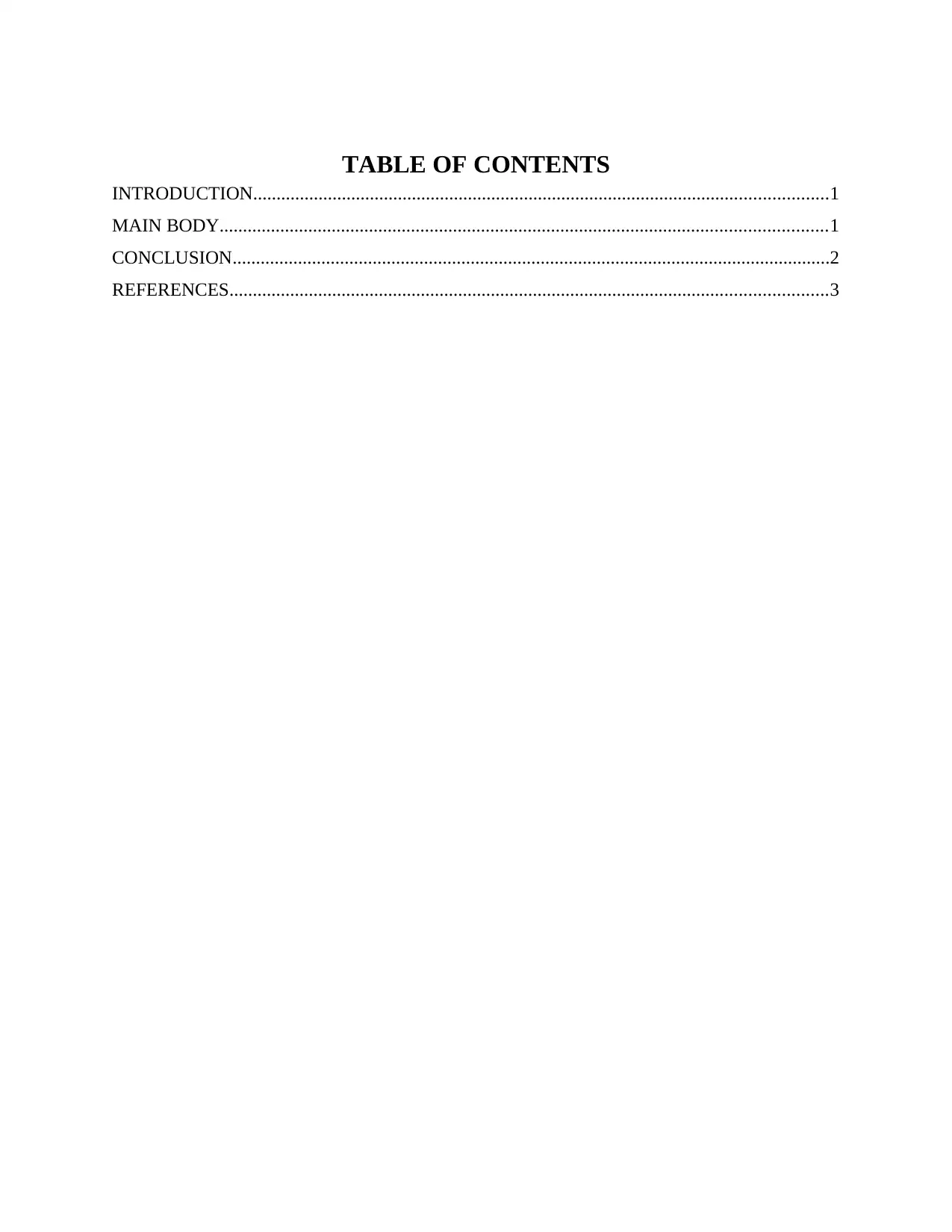
TABLE OF CONTENTS
INTRODUCTION...........................................................................................................................1
MAIN BODY..................................................................................................................................1
CONCLUSION................................................................................................................................2
REFERENCES................................................................................................................................3
INTRODUCTION...........................................................................................................................1
MAIN BODY..................................................................................................................................1
CONCLUSION................................................................................................................................2
REFERENCES................................................................................................................................3
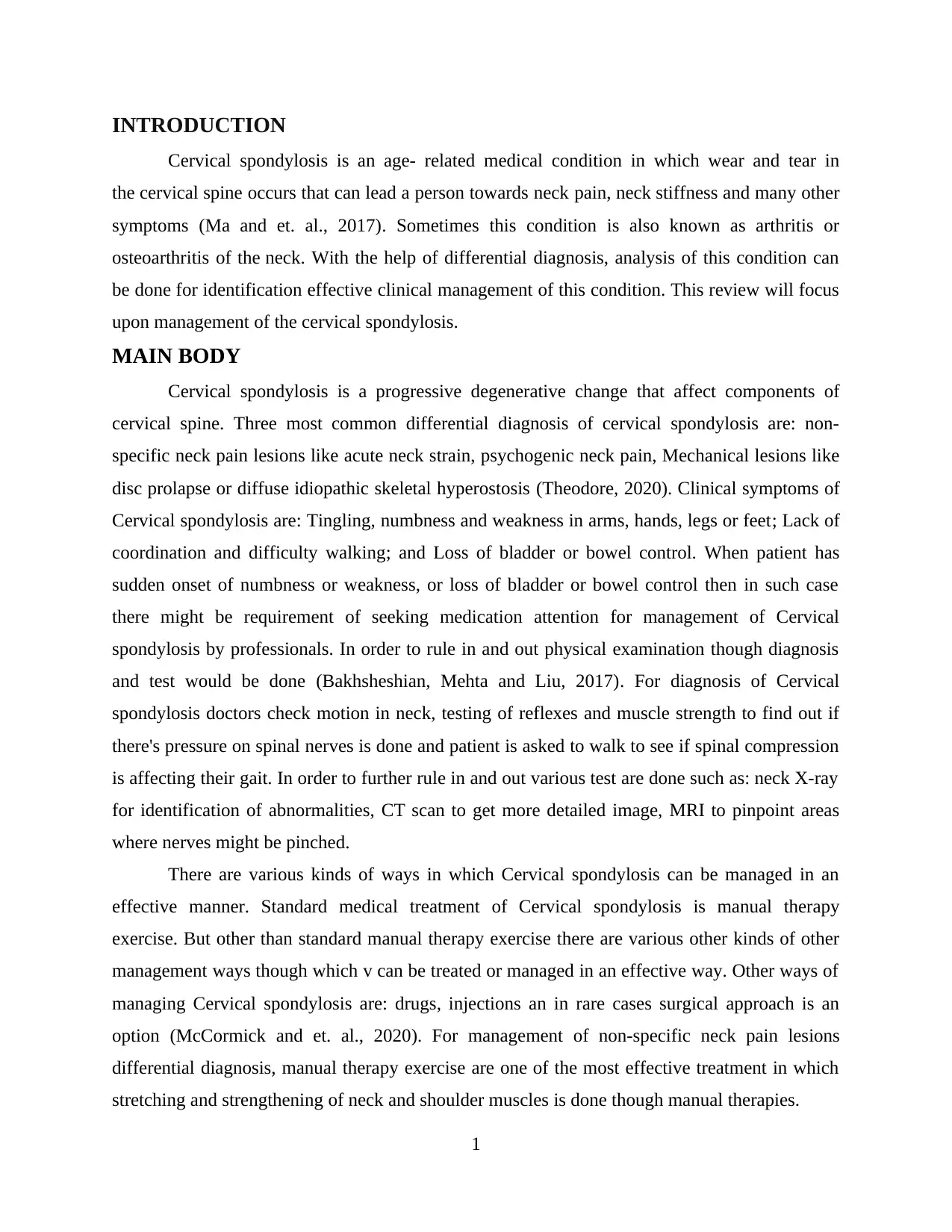
INTRODUCTION
Cervical spondylosis is an age- related medical condition in which wear and tear in
the cervical spine occurs that can lead a person towards neck pain, neck stiffness and many other
symptoms (Ma and et. al., 2017). Sometimes this condition is also known as arthritis or
osteoarthritis of the neck. With the help of differential diagnosis, analysis of this condition can
be done for identification effective clinical management of this condition. This review will focus
upon management of the cervical spondylosis.
MAIN BODY
Cervical spondylosis is a progressive degenerative change that affect components of
cervical spine. Three most common differential diagnosis of cervical spondylosis are: non-
specific neck pain lesions like acute neck strain, psychogenic neck pain, Mechanical lesions like
disc prolapse or diffuse idiopathic skeletal hyperostosis (Theodore, 2020). Clinical symptoms of
Cervical spondylosis are: Tingling, numbness and weakness in arms, hands, legs or feet; Lack of
coordination and difficulty walking; and Loss of bladder or bowel control. When patient has
sudden onset of numbness or weakness, or loss of bladder or bowel control then in such case
there might be requirement of seeking medication attention for management of Cervical
spondylosis by professionals. In order to rule in and out physical examination though diagnosis
and test would be done (Bakhsheshian, Mehta and Liu, 2017). For diagnosis of Cervical
spondylosis doctors check motion in neck, testing of reflexes and muscle strength to find out if
there's pressure on spinal nerves is done and patient is asked to walk to see if spinal compression
is affecting their gait. In order to further rule in and out various test are done such as: neck X-ray
for identification of abnormalities, CT scan to get more detailed image, MRI to pinpoint areas
where nerves might be pinched.
There are various kinds of ways in which Cervical spondylosis can be managed in an
effective manner. Standard medical treatment of Cervical spondylosis is manual therapy
exercise. But other than standard manual therapy exercise there are various other kinds of other
management ways though which v can be treated or managed in an effective way. Other ways of
managing Cervical spondylosis are: drugs, injections an in rare cases surgical approach is an
option (McCormick and et. al., 2020). For management of non-specific neck pain lesions
differential diagnosis, manual therapy exercise are one of the most effective treatment in which
stretching and strengthening of neck and shoulder muscles is done though manual therapies.
1
Cervical spondylosis is an age- related medical condition in which wear and tear in
the cervical spine occurs that can lead a person towards neck pain, neck stiffness and many other
symptoms (Ma and et. al., 2017). Sometimes this condition is also known as arthritis or
osteoarthritis of the neck. With the help of differential diagnosis, analysis of this condition can
be done for identification effective clinical management of this condition. This review will focus
upon management of the cervical spondylosis.
MAIN BODY
Cervical spondylosis is a progressive degenerative change that affect components of
cervical spine. Three most common differential diagnosis of cervical spondylosis are: non-
specific neck pain lesions like acute neck strain, psychogenic neck pain, Mechanical lesions like
disc prolapse or diffuse idiopathic skeletal hyperostosis (Theodore, 2020). Clinical symptoms of
Cervical spondylosis are: Tingling, numbness and weakness in arms, hands, legs or feet; Lack of
coordination and difficulty walking; and Loss of bladder or bowel control. When patient has
sudden onset of numbness or weakness, or loss of bladder or bowel control then in such case
there might be requirement of seeking medication attention for management of Cervical
spondylosis by professionals. In order to rule in and out physical examination though diagnosis
and test would be done (Bakhsheshian, Mehta and Liu, 2017). For diagnosis of Cervical
spondylosis doctors check motion in neck, testing of reflexes and muscle strength to find out if
there's pressure on spinal nerves is done and patient is asked to walk to see if spinal compression
is affecting their gait. In order to further rule in and out various test are done such as: neck X-ray
for identification of abnormalities, CT scan to get more detailed image, MRI to pinpoint areas
where nerves might be pinched.
There are various kinds of ways in which Cervical spondylosis can be managed in an
effective manner. Standard medical treatment of Cervical spondylosis is manual therapy
exercise. But other than standard manual therapy exercise there are various other kinds of other
management ways though which v can be treated or managed in an effective way. Other ways of
managing Cervical spondylosis are: drugs, injections an in rare cases surgical approach is an
option (McCormick and et. al., 2020). For management of non-specific neck pain lesions
differential diagnosis, manual therapy exercise are one of the most effective treatment in which
stretching and strengthening of neck and shoulder muscles is done though manual therapies.
1
⊘ This is a preview!⊘
Do you want full access?
Subscribe today to unlock all pages.

Trusted by 1+ million students worldwide
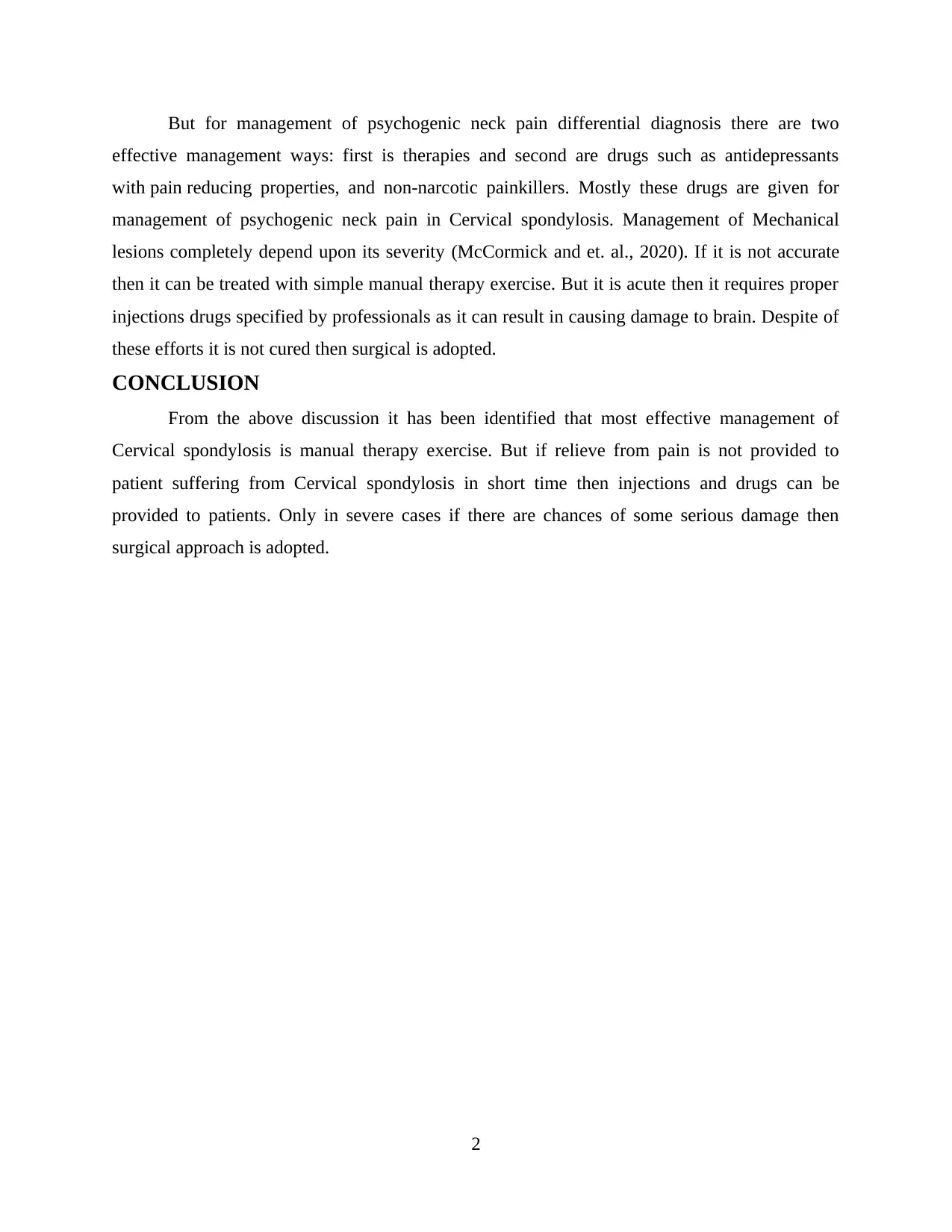
But for management of psychogenic neck pain differential diagnosis there are two
effective management ways: first is therapies and second are drugs such as antidepressants
with pain reducing properties, and non-narcotic painkillers. Mostly these drugs are given for
management of psychogenic neck pain in Cervical spondylosis. Management of Mechanical
lesions completely depend upon its severity (McCormick and et. al., 2020). If it is not accurate
then it can be treated with simple manual therapy exercise. But it is acute then it requires proper
injections drugs specified by professionals as it can result in causing damage to brain. Despite of
these efforts it is not cured then surgical is adopted.
CONCLUSION
From the above discussion it has been identified that most effective management of
Cervical spondylosis is manual therapy exercise. But if relieve from pain is not provided to
patient suffering from Cervical spondylosis in short time then injections and drugs can be
provided to patients. Only in severe cases if there are chances of some serious damage then
surgical approach is adopted.
2
effective management ways: first is therapies and second are drugs such as antidepressants
with pain reducing properties, and non-narcotic painkillers. Mostly these drugs are given for
management of psychogenic neck pain in Cervical spondylosis. Management of Mechanical
lesions completely depend upon its severity (McCormick and et. al., 2020). If it is not accurate
then it can be treated with simple manual therapy exercise. But it is acute then it requires proper
injections drugs specified by professionals as it can result in causing damage to brain. Despite of
these efforts it is not cured then surgical is adopted.
CONCLUSION
From the above discussion it has been identified that most effective management of
Cervical spondylosis is manual therapy exercise. But if relieve from pain is not provided to
patient suffering from Cervical spondylosis in short time then injections and drugs can be
provided to patients. Only in severe cases if there are chances of some serious damage then
surgical approach is adopted.
2
Paraphrase This Document
Need a fresh take? Get an instant paraphrase of this document with our AI Paraphraser
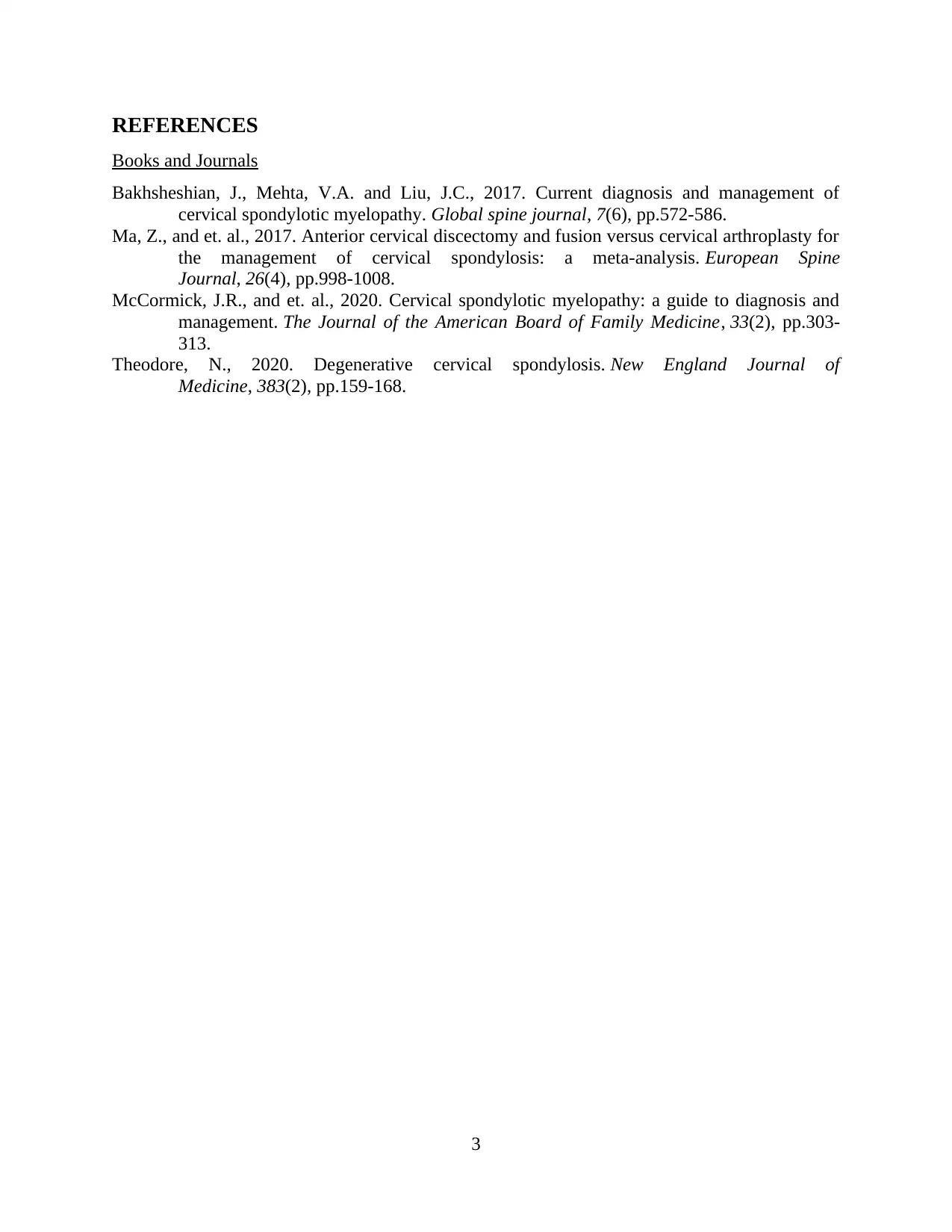
REFERENCES
Books and Journals
Bakhsheshian, J., Mehta, V.A. and Liu, J.C., 2017. Current diagnosis and management of
cervical spondylotic myelopathy. Global spine journal, 7(6), pp.572-586.
Ma, Z., and et. al., 2017. Anterior cervical discectomy and fusion versus cervical arthroplasty for
the management of cervical spondylosis: a meta-analysis. European Spine
Journal, 26(4), pp.998-1008.
McCormick, J.R., and et. al., 2020. Cervical spondylotic myelopathy: a guide to diagnosis and
management. The Journal of the American Board of Family Medicine, 33(2), pp.303-
313.
Theodore, N., 2020. Degenerative cervical spondylosis. New England Journal of
Medicine, 383(2), pp.159-168.
3
Books and Journals
Bakhsheshian, J., Mehta, V.A. and Liu, J.C., 2017. Current diagnosis and management of
cervical spondylotic myelopathy. Global spine journal, 7(6), pp.572-586.
Ma, Z., and et. al., 2017. Anterior cervical discectomy and fusion versus cervical arthroplasty for
the management of cervical spondylosis: a meta-analysis. European Spine
Journal, 26(4), pp.998-1008.
McCormick, J.R., and et. al., 2020. Cervical spondylotic myelopathy: a guide to diagnosis and
management. The Journal of the American Board of Family Medicine, 33(2), pp.303-
313.
Theodore, N., 2020. Degenerative cervical spondylosis. New England Journal of
Medicine, 383(2), pp.159-168.
3
1 out of 5
Your All-in-One AI-Powered Toolkit for Academic Success.
+13062052269
info@desklib.com
Available 24*7 on WhatsApp / Email
![[object Object]](/_next/static/media/star-bottom.7253800d.svg)
Unlock your academic potential
Copyright © 2020–2025 A2Z Services. All Rights Reserved. Developed and managed by ZUCOL.

